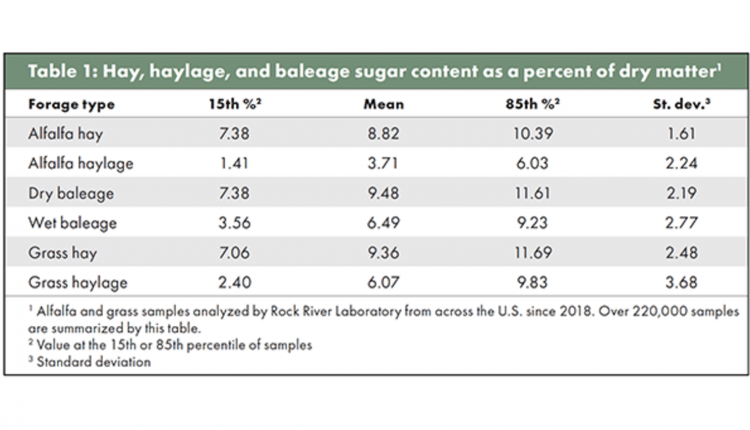The sweet forage component |
| By John Goeser |
|
|
|
The author is the director of nutrition research and innovation with Rock River Lab Inc, and adjunct assistant professor, University of Wisconsin-Madison’s Dairy Science Department. As the weather trends hotter, cold and sweet treats become more appealing. My two kids, aged 7 and 8 years old, have inherited my late father’s sweet tooth. My dad was known for being able to dive into donuts, bakery, or ice cream at any time of the day, including before meals! My kids don’t let me ignore the ice cream shop when it reopens with its bright neon lights and signage. Ice cream is a draw for my kids. I’m proud that they love their dairy foods, but the sugar, chocolate, and sprinkles act as sensory ignition, which sometimes equate to tantrums when we drive past the ice cream parlor without stopping. High-quality forage for dairy and beef cattle can be like ice cream for my kids. For exceptionally well-managed forage, a higher sugar level will be appealing to animals and draw them to the feedbunk. Our goal in forage production should be to optimize sugar content that will encourage dry matter intake. However, benchmarking sugar content when making management or variety changes can prove challenging. Sugar is a crude nutritional term that can better be defined as glucose, lactose, maltose, sucrose, and fructose, among other compounds. Sucrose and fructose are the primary plant sugars, with fructose being the major sugar in most forages and corn. Sucrose is found in sugar beets and sugarcane, and the appetizing table sugar is primarily sucrose. However, fructose is also sweet, and cattle seem to love forages rich with fructose. Forage and feed analysis laboratories have employed numerous techniques to quantify sugar — from crude sugar measures to very precise sugar compound identification. The crude sugar measures involve extracting sugar-like compounds with either ethanol or water, dyeing the solution with a certain chemical that reacts with sugar-like compounds, and then comparing the colorimetric intensity of the unknown solution with known standards. The more sugar in the solution, the greater the color intensity. I’ve explained the method because it’s almost too simple; however, both ethanol and water have been used over the past two decades and the results are substantially different. Water extracts more sugar than does ethanol. The ruminant nutrition world has shifted to using water-soluble carbohydrate (sugarWSC) measures to estimate the true sugar content in forages and feeds. In the future, forage and feed analysis will fully transition to more precise and accurate sugar measures, just like the techniques we employ for measuring fermentation compounds such as lactic acid, butyric acid, and other fermentation acids or alcohols. In the meantime, we’ll focus on sugarWSC as the sweetness indicator for different forage types to visualize differences. Hay and haylage differ Both alfalfa and grass hay and haylages are substantially different in sugar concentration. The difference visible in Table 1 is primarily due to the fact that fermenting bacteria consume sugar during the ensiling process. The offset to the lower sugar level are fermentation acids that cure the forage and preserve it for months and years to come at higher moisture concentrations. Grass also tends to have a higher sugar content than alfalfa, and this is more apparent for grass haylage relative to alfalfa haylage (Table 1). This difference is likely due to the inherent difference in sugar content with forage grasses relative to alfalfa, and not preservation effects.  Hybridizing haylage and hay, baleage is a unique feed that cattle tend to crave when harvested and stored correctly. Part of the reason this feed is sought out in the ration is the high sugar content relative to haylage (Table 1). In fact, sugar content in baleage looks more like hay than it does haylage. The greater sugar content with baleage is more apparent with drier wrapped hay that doesn’t go through a fermentation, which some call “sweet hay.” For wetter, fermented baleage, we still observe a greater sugar content than haylage, which could be attributed to a less efficient fermentation and retaining a bit more sugar through stabilizing the forage. If your farm is considering different storage options for your alfalfa or grass, and sugar is of interest, hay and baleage clearly show an advantage in sugar content. In closing, ensure your management program considers the sugar content of your forages and use the right sugar measurement when benchmarking. High-sugar forages for dairy and beef cattle can be like ice cream to children. The sugar content in each of these is the driving factor toward exceptional palatability and taste, and pushing for higher forage consumption can dramatically improve your bottom line. This article appeared in the April/May 2022 issue of Hay & Forage Grower on page 29. Not a subscriber? Click to get the print magazine. |
